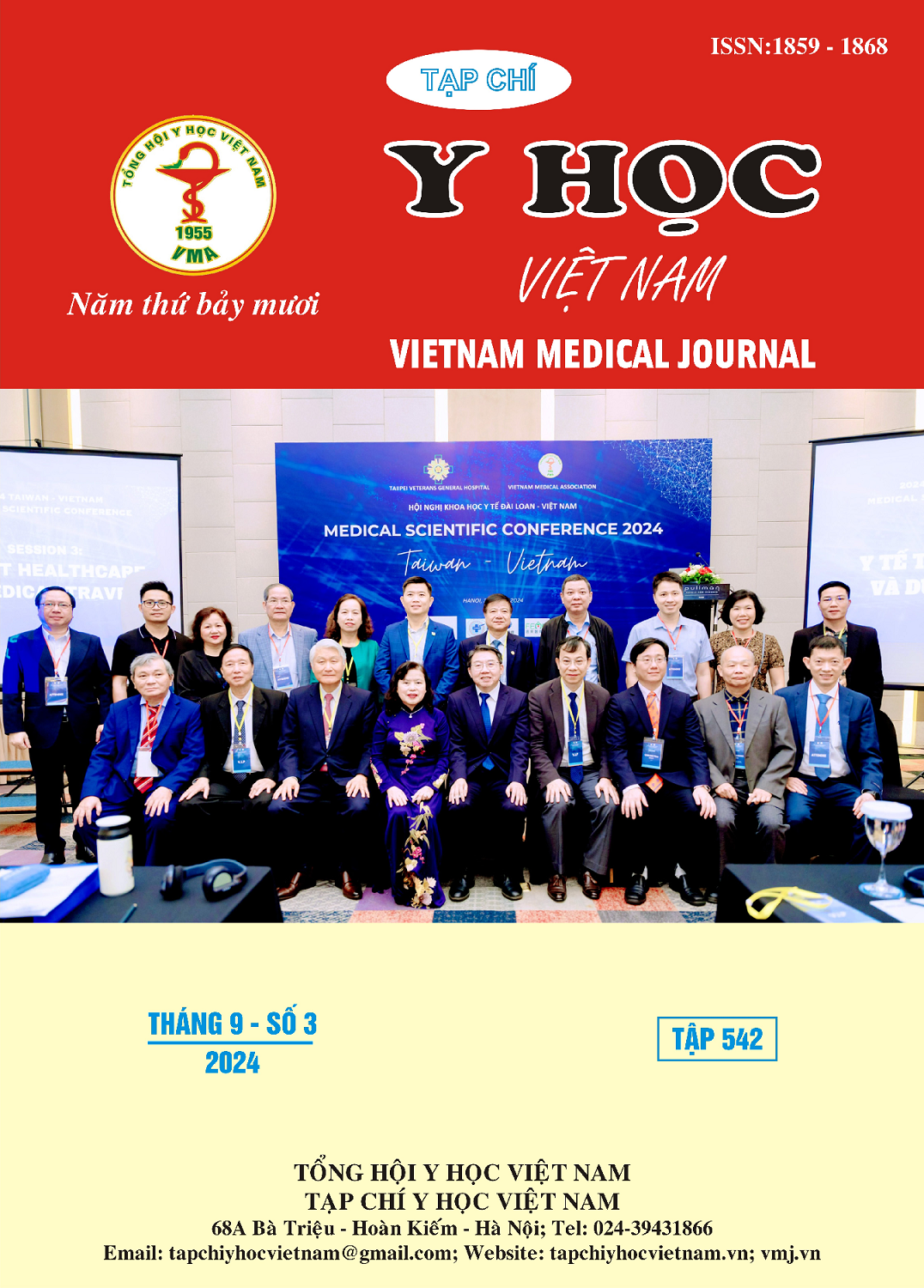EFFICIENCY OF PLACEMENT OF PROPHYLACTIC MESH USING SUGARBAKER TECHNIQUE DURING LAPAROSCOPIC ABDOMINOPERINEAL RESECTION FOR RECTAL CANCER
Main Article Content
Abstract
Aims: The study aim was to evaluate efficiency of parastomal hernia prevention through placement of a prosthetic mesh using Sugarbaker technique during laparoscopic abdominoperineal resection for rectal cancer after 1 year follow up at University Medical Center, Ho Chi Minh City. Methods: Intervention study. Between 11/2018 and 7/2023, a total of 56 patients with low rectal cancer underwent laparoscopic abdominoperineal resection and divided into two groups: intervention group with prophylactic mesh placement using Sugarbaker technique (n = 28) and control group without prophylactic mesh placement (n = 28). All patients were followed at least 12 months and had abdominal computed tomography scan. Kaplan Meier method was used to analyze rate of parastomal hernia at 1 year. The logrank test was used to compare rate of parastomal hernia between two groups. Results: There were 56 patients included in this study, the male to female ratio was approximately equal to 1:1, the median age was 62, youngest age 40, oldest age 92. Incidence of rectal cancer stage III was 44,6%. The rate of neoadjuvant chemoradiotherapy was 26,7%. The median operating time was 184 minutes. The median mesh placement time was 15 minutes. Total complications rate was 16,4%. There were no mesh placement-related complications. The cumulative rate of a parastomal hernia at 1 year in control group was higher than intervention group (35.7% versus 0%, logrank 6.4, p=0.01). Conclusions: Prophylactic mesh placement using Sugarbaker technique during laparoscopic abdominoperineal resection for rectal cacner is safe, does not increase complications and decrease the cumulative rate of a parastomal hernia at 1 year in patients undergoing prophylactic mesh placement using Sugarbaker technique
Article Details
Keywords
Prophylactic mesh placement, Sugarbaker technique, Laparoscopic abdominoperineal resection
References
2. Campos, F.G., The life and legacy of William Ernest Miles (1869-1947): a tribute to an admirable surgeon. Revista da Associação Médica Brasileira, 2013. 59: p. 181-185.
3. Voitk, A., Simple technique for laparoscopic paracolostomy hernia repair. Dis Colon Rectum, 2000. 43(10): p. 1451-3.
4. Hauters, P., et al., Long-term assessment of parastomal hernia prevention by intra-peritoneal mesh reinforcement according to the modified Sugarbaker technique. Surg Endosc, 2016. 30 (12): p. 5372-5379.
5. López-Cano, M., et al., Use of a prosthetic mesh to prevent parastomal hernia during laparoscopic abdominoperineal resection: a randomized controlled trial. Hernia, 2012. 16(6): p. 661-7.
6. López-Cano, M., et al., Preventing Parastomal Hernia Using a Modified Sugarbaker Technique With Composite Mesh During Laparoscopic Abdominoperineal Resection: A Randomized Controlled Trial. Ann Surg, 2016. 264(6): p. 923-928.
7. Pham Ngoc Truong Vinh, N.H.T., Hoang Danh Tan, Le Minh Triet, Tran Duc Huy, Le Trung Kien, Le Trinh Ngoc An, Ung Van Viet, Kết quả sớm của phẫu thuật nội soi đặt lưới dự phòng thoát vị cạnh hậu môn nhân tạo theo kĩ thuật Sugarbaker ở người bệnh ung thư trực tràng có phẫu thuật Miles. Y Học TP. Hồ Chí Minh, 2021. 6(25): p. 309-315.
8. Antoniou, S.A., et al., European Hernia Society guidelines on prevention and treatment of parastomal hernias. Hernia, 2018. 22(1): p.183-198.
9. Vierimaa, M., et al., Prospective, Randomized Study on the Use of a Prosthetic Mesh for Prevention of Parastomal Hernia of Permanent Colostomy. Dis Colon Rectum, 2015. 58(10): p. 943-9.
10. Figel, N.A., J.W. Rostas, and C.N. Ellis, Outcomes using a bioprosthetic mesh at the time of permanent stoma creation in preventing a parastomal hernia: a value analysis. Am J Surg, 2012. 203(3): p. 323-6; discussion 326.


